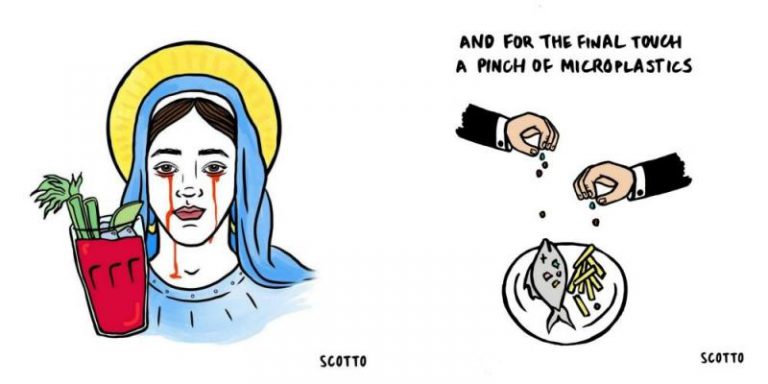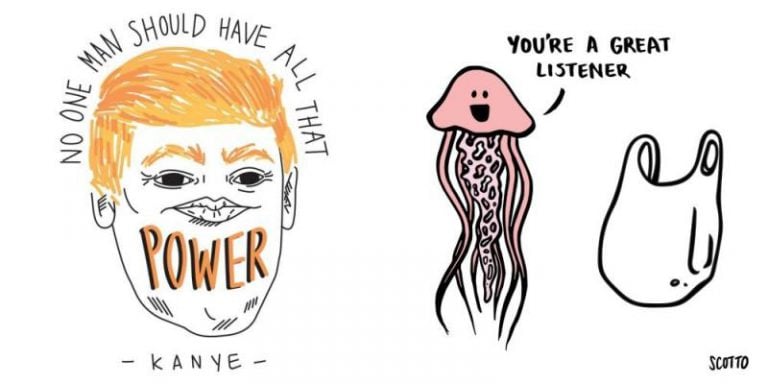“Even if I knew that tomorrow the world would go to pieces, I would still plant my apple tree.” Cited by the designer herself, it is this Martin Luther King quote that perfectly sums up the hope and optimism with which Melbourne-based Carla Scotto approaches her life’s work.
The 23-year-old who heads her eponymous business, Carla Scotto Designs has made a name for herself with her quirky illustrations and comics that go a long way in not only ticking boxes in her desire to create, but in educating the masses about matters of social justice and the environment.
Of Italian and Greek heritage, Scotto’s maternal grandparents are from the island of Crete, she has been painting since the age of two, but revealed that her pursuit of the arts came to a standstill after making it into Top Arts in Year 12.
“I thought ‘this is probably the last time I’m going to exhibit’ because I just didn’t think you could be an artist as a career. To me artists always sounded poor,” she says with a laugh.
Despite her parents’ encouragement however, she took time off and turned her attention to her double majors in French and Chinese at university. After completing her degree, Carla then went travelling and would return to Melbourne to go back to study and, ultimately, her first love.
“I took a huge break from art and it really ruined me, because if you do it all the time and then suddenly stop it’s like a huge gap in your life,” she reveals.
Since completing an intensive course in graphic design at Shillington College, the designer has made a habit of only looking forward. In just a short time she has made it her mission to pursue social justice by teaming with organisations like UNESCO and Take 3 for the Sea, and doing pro bono work for a number of charities.
Neos Kosmos reached out to Carla to find out more about what inspires and challenges her, and her hopes for the environment.
How did you come to be illustrating?
I have an uncle in Italy who is a really awesome painter, and when I went to visit him as a kid he was insisting my parents put me into art classes as soon as we got home. So I did that for about a decade. There was like an art gene through the family and both of his sons missed out on it, but I actually got it. So I did a lot of oil painting growing up and then only recently sort of transitioned to more digital art and I still do things by hand, but it’s very different to what I used to do.

Your transition from one format to the other was quite drastic. What drew you to digital art?
I lost the patience to spend six months on a piece and also because oil paint is not cheap, it’s a long process; it takes about 24 to 48 hours to dry, so you’re constantly working with something. And then I did a three month intensive course at Shillington in Melbourne. I always wanted to know how to digitise my work or make it applicable online so you could blow it up to whatever size; I just really wanted to do that and I picked it up along the way. But it was the illustration that kept me more enthralled than the design. I do a lot of design but if I can incorporate illustration wherever I can, it makes it a million times more enjoyable.
Anyone who is familiar with your work, is also aware that you’re an environmentalist. How does your artistic medium help you in getting your ideas and values across?
I feel I have a means of communicating complicated ideas really quickly and effectively to people who would otherwise not get caught up in these ideas; it just doesn’t phase them as much as it can often phase me. I don’t want the work that I create to be meaningless, so I create meaning where I can. Not all the time, but as much as I can.

Is giving your work another dimension something that comes naturally to you?
It’s relatively easy just because of how much media I probably consume staring at a computer all day. I would also say I’m relatively intense, so I have intense feelings about a lot of things and to generate a comic about it is a means of getting it out for me, more than anything else. It’s not about preaching, it’s just ‘this is on my mind, here’s a quick way to get it out’.
Since starting Carla Scotto design, you’ve developed a following online. What kind of feedback have you received?
I would say really diverse. I don’t upload on a regular basis because I don’t just want to devote myself to social media; it’s not everything. But because I have diverse ideas, I have a diverse audience and I feel like I’m constantly catering to different people. The thing I read the most are comments saying ‘this made me sad, but I also laughed. I learnt something’ so that’s good.
Have you been involved in any interesting collaborations?
I’ve done a lot of diverse stuff because I couldn’t hone in on one thing that I wanted to do. I did a brochure for UNESCO in Jakarta and I did a skateboard recently for a charity called Decks for Change and it’s been auctioned off to build a skate park in Nepal.
I’ve also helped a lot of my friends’ projects come to light. Like my friend who’s running a feminist film festival in November this year. I buckled down and did all her branding for her and she won a grant from Monash for $10,000, which was huge for us. Another fem blog called Girls Will Be Girls I also helped out with.

From the projects you have chosen to work on, it’s clear you’re very socially engaged. Is it important that future clients’ values align with yours?
It’s a deal breaker. My name goes on it, and my name is its own brand now. I’m finding as I’m getting older and I’ve been doing it for a bit longer that I’m more picky about who I work with.
Have you noticed any changes within the design industry over time?
In Australia there’s a lot of outsourcing with design especially. In the digital age it is easier to find something cheaper but that’s not what you should be looking for when it comes to design. You should be looking at doing something once and doing it right, so you don’t have to touch it for four years. You also lose cultural context by outsourcing work, you can’t understand cultural connotations if you don’t live in a place. That’s one of the biggest problems; people looking to cut corners are devaluing the work more and more. But I feel younger people understand the value of design more.
Now more than ever, even from an environmental perspective, we need to have a local focus from our food to every aspect of life. Everything we consume, everything we buy is so stretched away from where we are. It’s such a drain on resources.

But for that to happen every industry has to work together. Wages need to be equivalent to the cost of buying local, and our value system needs to change. I am hopeful though.
There’s so many things you need to educate people on. I’m thinking of ways of associating guilt to people. I want people to feel guilt when they use plastic, I want people to attain a sense of responsibility when they purchase something – to the entire life span of the product. We live in such a linear economy; we buy something, we throw it out. We all do it and an inconceivable amount of waste is occurring. I want people to start feeling guilty and to stop being so blasé in their day-to-day especially here in Australia because we are so lucky people don’t care enough.
But I know if people see the comic it’ll be a reminder for them, even if they don’t quit plastic. They’ll think about it the next time they go to buy something and that’s where I get relief that at least I’m doing that.
Aside from engaging with the media, do you have any other sources of inspiration?
A lot. There are so many artists I’ve discovered through the very powerful tool of Instagram. There are a lot of illustrators I admire, one in particular is (JAIK) PUPPYTEETH. He does some really sarcastic, dark comics. Also all my inspiration ever has come from having done Renaissance art history and all I did growing up was copy masters to get technical skill under my belt. I still get great satisfaction from incorporating that into my work from time to time. I love rehashing old work and bringing it about in a new form.

So what’s next for Carla Scotto?
I’m in the midst of a change at the moment in terms of the content I’m producing. I still want to retain the meaning I’ve been putting into it but I want it to be more structured. I’ve been talking to Take 3 for the Sea about potentially designing merchandise and info booklets about how problematic our recycling systems are; just bringing these ideas to light that people don’t usually take into consideration. So that’s my next step.
To see more of Carla Scotto’s designs visit her page on Facebook facebook.com/carlascottodesign and follow her on Instagram @carlblah
